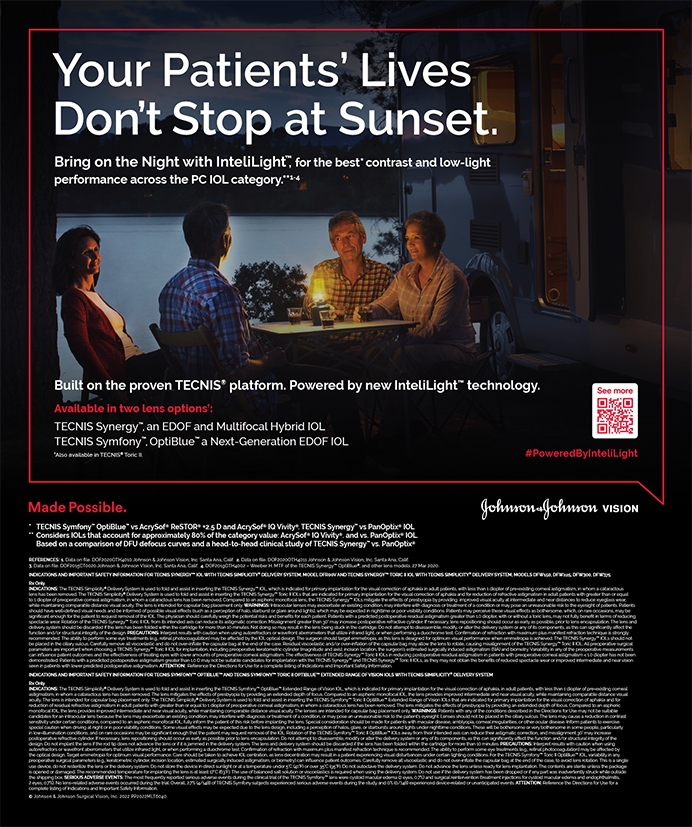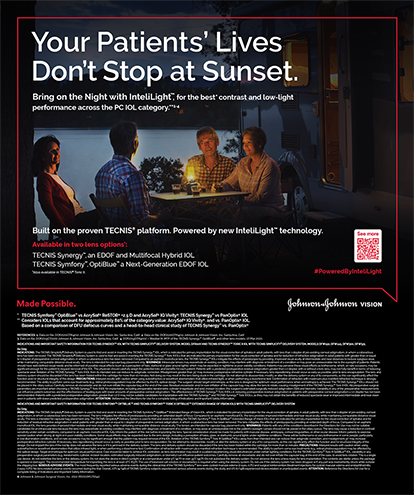Ambrosio et al1 conducted a retrospective analysis of 1,392 refractive screening evaluations to review topographic and ultrasound pachymetry findings with the Humphrey Atlas (Carl Zeiss Meditec Inc., Dublin, CA). A total of 18 (1.3%) keratorefractive candidates had topographic abnormalities and/or reduced pachymetry readings. Corneal topography is the most sensitive method for detecting corneal ectatic disorders such as keratoconus and pellucid marginal degeneration. Signs of ectasia appear on topographic maps before biomicroscopy can identify ectasia-related corneal abnormalities such as stromal thinning, Fleischer's ring, Vogt's striae, or Munson's sign.1
Pachymetry may describe the general health of the cornea, but the range of normal thickness is wide. The average corneal thickness is 540µm. Intrastromal pachymetry, as well as preoperative full-thickness readings, should be measured in all patients prior to excimer ablation. Suggested strategies to avoid ectasia following LASIK include limiting the total depth of keratectomy to a maximum of 50% of the total corneal thickness and preserving a residual bed thickness of 250 or 300µm.1 Additionally, it is important that surgeons understand the limitations of the keratome. For example, the flap created using the Hansatome's (Bausch & Lomb, Rochester, NY) 160-µm plate tends to result in a slightly thinner flap (149µm), but the range is significant (103 to 205µm).2
POSTERIOR SURFACE CHANGES AFTER LASIKLee et al2 retrospectively investigated the forward shift of the posterior corneal surface relative to the residual bed thickness and the ablation percentage of the total thickness in 363 eyes of 182 patients using the Orbscan II (Bausch & Lomb). They found the likelihood of the forward shift of the posterior surface increased as residual stromal bed thickness decreased and as the ratio of the ablation to the total corneal thickness increased.
Twa et al3 investigated the response of the posterior surface following 5,211 myopic LASIK procedures in 2,439 patients, including only primary treatments. Rather than use the percentage of ablation, the investigators considered direct measures of pre- and postoperative corneal thickness. They found that the postoperative, anterior, best-fit sphere radius of curvature, ablation depth, postoperative pachymetry, patient age, and residual mean spherical equivalent were the best predictors of the posterior best-fit sphere radius of curvature following LASIK. This predictor accounted for 46% of the variance. A smaller radius of curvature was associated with a greater ablation depth, reduced corneal thickness postoperatively, younger age, and increased residual myopic refractive error.3
Twa et al3 also evaluated corneal elevation in virgin eyes and those that had undergone LASIK. Preoperatively, the highest location of the cornea above the best-fit sphere was in the inferior temporal quadrant. After LASIK, the elevated cornea remained skewed toward the inferior quadrant but was more symmetrically centered around the corneal optical center. Investigators attributed this corneal elevation to a more prolate corneal shape post-LASIK or to the ablation's location at the center of the cornea. Postoperative corneal thickness was the most important predictor for elevation, followed by residual refractive error. Investigators also found that the thicker the cornea was preoperatively, the greater the corneal elevation was following LASIK, possibly due to the fact that greater treatments may be applied to thicker corneas.3
Several postoperative clinical findings were associated with ectasia, including a BSCVA of 20/25 or worse, residual astigmatism ≥ 1.25D, corneal toricity ≥ 1.40D, a residual refractive error of ≥ -2.00D (spherical equivalent), a total postoperative corneal pachymetry of ≤ 400µm, a programmed ablation of > 75µm, and a loss of two or more lines of visual acuity.3
Miyata et al4 investigated the amount of forward shifting following LASIK in relation to the residual bed thickness, preoperative pachymetry, myopic correction, IOP, and amount of ablation in 164 eyes of 85 patients. Patients were evaluated using the Orbscan II preoperatively and at 1 month. Using regression analysis, investigators found the relevant variables included the amount of ablated tissue and preoperative corneal thickness. The residual bed's thickness was not highly correlated to a forward shift of the posterior surface.
MECHANICAL RESPONSE TO LASIKGrzybowski et al5 studied posterior surface changes after LASIK in 2,380 eyes of 1,255 patients using the Orbscan II topographer. Difference maps were obtained at baseline and 6 months postoperatively using three different fitting protocols: (1) apex, (2) all-over, and (3) peripheral. The investigators analyzed the maps to understand corneal behavior after LASIK. They found the postoperative increase in central curvature and the elevation of the posterior surface to be due to a backward swelling of the peripheral cornea into the anterior chamber. The investigators suggested that the modification of the posterior surface after LASIK represents a stable remodeling response in most cases, although pathological ectasia can occur. Differences in the stromal lamellae's organization as well as in the fibrils within the lamellae are thought to be responsible for the differences in swelling properties between the anterior and posterior stroma.5
LIMITATION OF POSTERIOR SURFACE EVALUATIONThe development of the Orbscan allows ophthalmologists to evaluate the posterior and anterior surface of the cornea. However, posterior surface findings via this instrument could not be validated. According to Cairns et al,6 the Orbscan's detection of the slit image requires the tested surface to scatter light evenly in all directions. A reduction in scatter, say by a semitransparent material such as the cornea, creates less defined slit images.6 This phenomenon would be especially true when scanning the posterior surface of the cornea. Although its development has certainly opened practitioners' eyes to the attributes of the cornea, until another instrument is able to measure the posterior surface, physicians must be careful not to forget that the Orbscan is a one-of-a-kind instrument.
THE BOTTOM LINERefractive surgeons may avoid ectasia in post-LASIK patients by limiting the total depth of the keratectomy to a maximum of 50% of the total corneal thickness, by maintaining a residual bed thickness of 250 to 300µm, and by considering thickness specific to the microkeratome used.
Surgeons need to consider certain clinical findings to rule out ectasia, such as a loss of BCVA, increased astigmatism, significant myopia, and pachymetry, before proceeding with further treatment. Mild ectasia may be due to a backward swelling of the peripheral cornea rather than a pathological forward bulging of the central cornea.
ReviewerTracy Swartz, OD, MS, states that she holds no financial interest in any product or company mentioned herein. She may be reached at (615) 321-8881; drswartz@wangvisioninstitute.com. Panel Members
Y. Ralph Chu, MD, is Medical Director, Chu Vision Institute in Edina, Minnesota. He states that he holds no financial interest in any product or company mentioned herein. Dr. Chu may be reached at (952) 835-1235; yrchu@chuvision.com.
Nina Goyal, MD, is a resident in ophthalmology at the Rush University Medical Center in Chicago. She states that she holds no financial interest in any product or company mentioned herein. Dr. Goyal may be reached at (312) 942-5315; ninagoyal@yahoo.com.
Wei Jiang, MD, is a resident in ophthalmology at the Jules Stein Eye Institute in Los Angeles. She states that she holds no financial interest in any product or company mentioned herein. Dr. Jiang may be reached at (310) 825-5000; wjiang70@yahoo.com.
Baseer Khan, MD, is a senior resident in ophthalmology in the Department of Ophthalmology at the University of Toronto. He states that he holds no financial interest in any product or company mentioned herein. Dr. Khan may be reached at (415) 258-8211; bob.khan@utoronto.ca.
Gregory J. McCormick, MD, is an ophthalmology resident at the University of Rochester Eye Institute in New York. He states that he holds no financial interest in any company or product mentioned herein. He may be reached at (585) 256-2569; mccormick_greg@hotmail.com.
Jay S. Pepose, MD, PhD, is Professor of Clinical Ophthalmology & Visual Sciences, Washington University School of Medicine, St. Louis. He states that he holds no financial interest in any product or company mentioned herein. Dr. Pepose may be reached at (636) 728-0111; jpepose@peposevision.com.
Paul Sanghera, MD, is a resident in ophthalmology in the Department of Ophthalmology and Vision Sciences at the University of Toronto. He states that he holds no financial interest in any product or company mentioned herein. He may be reached at (416) 666-7115; sanghera@rogers.com.
Renée Solomon, MD, is an ophthalmology fellow at Ophthalmic Consultants of Long Island in New York. She states that she holds no financial interest in any product or company mentioned herein. Dr. Solomon may be reached at rensight@yahoo.com.
Ming Wang, MD, PhD, states that he holds no financial interest in any product or company mentioned herein. He may be reached at (615) 321-8881; drwang@wangvisioninstitute.com.
For a downloadable pdf of this article, including Tables and Figures, click here.


